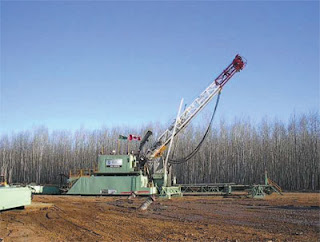 |
| slant drilling rig |
Laurie managed to spit out the term of art for what is colloquially known as "slant drilling," or more formally "directional drilling." She also managed to explain that the technique (actually, techniques, plural) is used "for extracting oil or gas resources " by drilling a hole that isn't vertical. Once she got that out of the way, Childree had the following to say about how oil and gas companies (or, for that matter anyone) accomplish this feat:
[This Space Intentionally Left Blank.]
Yep, Laurie spit out a bunch of examples of when directional drilling might be used plus the "advantages" of doing so, but said exactly zero about the process of drilling in her 416-word opus. No mention of whipstocking, no mention of mud motors, no mention of gyroscopic control; just lots and lots of half-baked verbiage; substantial portions of which are at best misleading and at worst incorrect. For example...
- "In some cases, slant drilling provides pressure relief when a vertical well malfunctions." – Rather than "some," Laurie's adjective should have been "[very] rare." Relief wells are drilled a few times a decade. They are considered a solution of last resort because drilling one is extremely slow.
- "Natural gas and oil reservoirs are sometimes located beneath inaccessible areas such as lakes, mountains, glaciers, or residential areas." – We know of no reservoirs under glaciers; not to mention that we howled with laughter at the notion that "beneath... mountains" necessitates directional drilling... or that's even a description of a place!
- "...a well is drilled at a 30-45 degree angle to tap into the reservoir from another location..." – The definition of a directional well as "drilled at a 30-45 degree angle" is hogwash. Most directional wells are started vertical and then "turned" in the subsurface, but there is no typical angle. The slant rig depicted above is most used for drilling water wells.
- "Slant drilling can allow a single offshore drilling rig to gain access to more than 20 wells." – Here Childree conflates an offshore platform with a "drilling rig," which are not the same things. Offshore wells are drilled (and produced) from platforms, not "drilling rigs."
- "Allowing multiple wellheads at a single offshore location can also help to reduce the overall cost of oil and natural gas exploration." – Not really. It reduces the cost of production, but the "single offshore location" she alludes to is far too costly for exploration.
- "Production costs can be further reduced by permitting crews to bypass dense, rocky soil by drilling non-vertical wells from a location with fewer obstructions." – Clearly, Childree knew nothing about oil and gas reservoirs. This might be true for water wells, but oil drillers laugh at "dense, rocky soil"!
No, our Dumbass of the Day thought she had her topic nailed, but we're here to tell you that she did not. Not only was what she published relatively useless because of its inaccuracies, she also neglected to explain just how directional drilling is accomplished. Not to be mean, but that's pretty much par for the course among WiseGEEK's (and thus AboutMechanics's) freelancers trying to explain the petroleum industry. Sigh.
DD - OIL
No comments:
Post a Comment